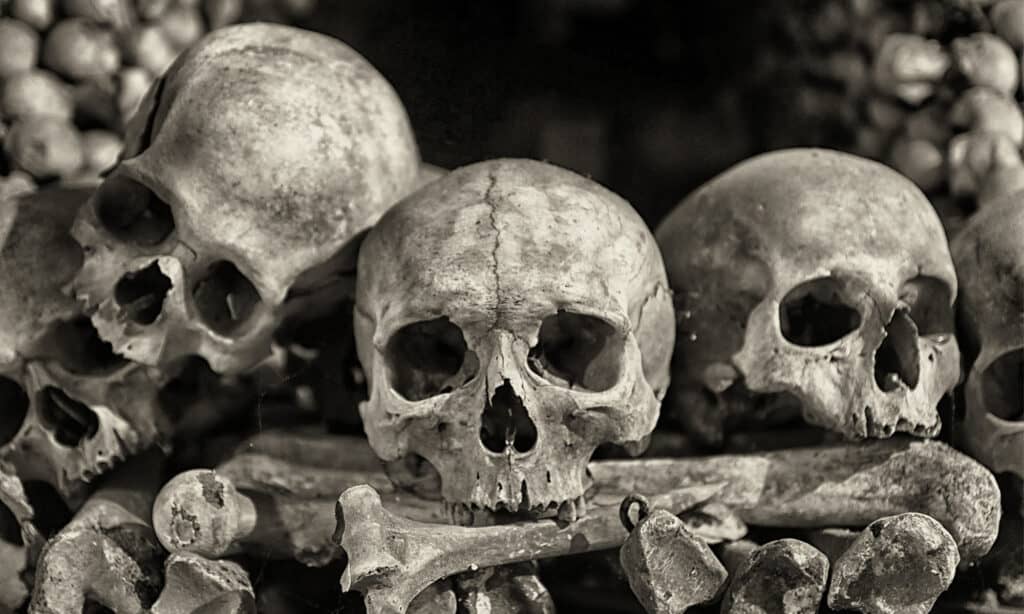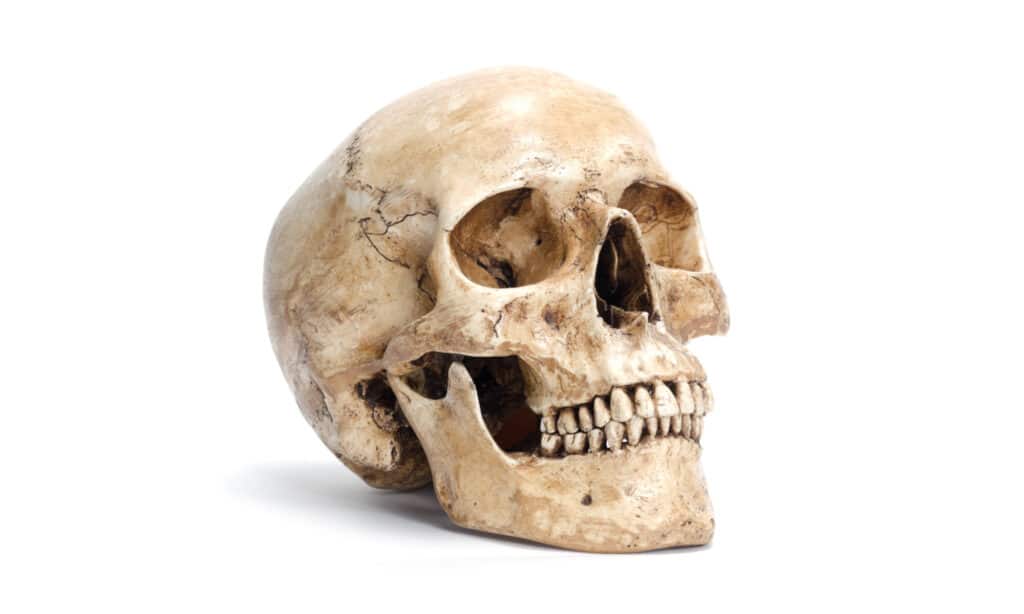When you mention the human skull, many unconsciously assume that the skull is one big whole round bone that protects the human head. But is this true? Is the human skull just one whole bone, or is it a collection of bones? This article discusses the number of bones in the human skull.
Background on the Human Skull?

The brain is protected by the bones of the skull.
©iStock.com/AndrisL
The human skull forms the skeletal frame and structure protecting the human head and brain. The skull is not one whole bone but a series of bones that come together to protect all the vital organs in the head. These include the brain (cerebellum, cerebrum, brainstem) and the orbit of the eyes. The skull also provides a structural anchor for tendinous and muscular attachments of the muscles of the scalp and face. It also protects the various nerves and muscles that feed and supply the brain, facial muscles, and skin with nerves.
How Many Bones Make Up The Human Skull?

There are 22 bones in the human skull.
©Chokniti Khongchum/Shutterstock.com
As opposed to the popular assumption that the skull is one whole round bone, it comprises 22 different bones, each serving a specific purpose in its position. These bones can be divided into the cranial bones, which enclose the human brain within the neurocranium, and the facial skeletal bones. The cranium bones are eight cranial bones, while the facial skeletal bones make up the remaining 14 bones in the human skull. The bones in the human skull are held together by sutures, a kind of immovable synarthrodial joint. There are four different types of sutures which include:
- The coronal suture that holds together the frontal and the parietal bones.
- The sagittal structure which holds together the two parietal bones.
- The lambdoid suture holds together the parietal and the occipital bones.
- The lambdoid suture firmly holds the occipital bone with the two parietal bones.
Examining The Skull Bones

There are 8 cranial and 14 facial skeletal bones.
©pattang/Shutterstock.com
The skull bones are divided into the cranial and the facial skeletal bones.
The Cranial Bones
The cranial bones are the 8 bones that make up the cranium, which is the part of the human skull that covers the brain. The eight bones that make up the skull include:
Frontal Bone(1)
The frontal bone is the bony part of the forehead and the bony orbital cavity, which holds the human eyes. The frontal bone comprises two portions, one vertically oriented squamous part and a horizontally oriented orbital part.
Parietal Bone(2)
This bone comes next after the frontal bone and sits at the top of the head while extending to the sides. It comprises portions attached to the frontal bone in front, the occipital bone at the back, and the temporal and sphenoid bones below.
Temporal Bone(2)
The temporal bones form the sides and base of the cranium. They serve as protective shields for the brain’s temporal lobe while surrounding the ear canal, which makes them very instrumental in controlling hearing and balance.
Occipital Bone(1)
The occipital bone is the trapezoid-shaped bone that occupies the lower part of the cranium. This bone houses and protects the back part of the brain and fuses with all the bones in your skull as one ages. It fuses with the sphenoid bone between the ages of 18 and 25 and the parietal bone between 26 and 40. The occipital bone is important as it connects the spinal cord to the skull and is essential for movement, flexibility, balance, and stability.
Sphenoid Bone(1)
The sphenoid, also called the wasp bone, is the unconnected bone in the cranium. It has a butterfly shape, and it is located in the central portion of the skull and helps form the base and lateral sides of the skull in combination with the orbital floor.
Ethmoid Bone(1)
The ethmoid bone is in the center of the skull between the eyes. It is essential to the formation of the walls of the eye socket or orbital cavity, the roof, sides, and interior of the nasal cavity.
The Facial Skeletal Bones
The 14 other bones that make up the skull are identified as facial skeletal bones. They include:
Two Nasal Conchae
These are thin bony elements that make up the upper chambers of the nasal cavities. They are composed of three pairs: the inferior, middle, and superior conchae.
Two Nasal Bones
The nasal bones form the nose bridge and are joined together by the nasal suture. These two oblong-shaped bones have two surfaces and four borders each. These bones are placed side by side in the middle and upper part of the face.
Two Maxilla Bones
The maxilla bones are the two bones that fuse at the intermaxillary suture (an area below the nose) to form the upper part of the mouth. The two halves are irregularly shaped bones that form part of the structure of the lower parts and sides of your sinus and nasal cavities and the lower parts of the eye socket.
Two Palatine Bones
These bones are the L-shaped paired bones joined to each other at the middle line. They intersect with the maxilla bones to form the hard palate, separating the oral cavity from the nasal cavity.
Two Lacrimal Bones
The lacrimal bone is a small bone in the medial wall of the orbit. It is the size of a fingernail and, consequently, the smallest bone in the human skull. It serves as a support to the structures of the lacrimal apparatus, which secretes tears for optical lubrication.
Two Zygomatic Bones
These two bones form the lateral rim and wall of the orbit and form the anterior zygomatic arch. It is also a major part of the cheek skeleton and an attachment for the masseter muscle. These bones articulate with the maxilla, temporal, sphenoid, and frontal bones.
Mandible
The mandible is the only one of the skull that is not attached to the rest by sutures, making it the only mobile bone in the whole human skull. It is also called the jaw bone and holds all the lower teeth together. It is also worth mentioning that this is the strongest bone in the skull.
Vomer
This single unpaired bone forms part of the nasal septum and is shaped like a plow. It articulates with the sphenoid, ethmoid, palatine, and the maxillary bones.
The photo featured at the top of this post is © Chokniti Khongchum/Shutterstock.com
Thank you for reading! Have some feedback for us? Contact the AZ Animals editorial team.






